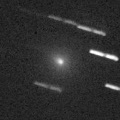
|
Now it is 11.7 mag (Feb. 10, Chris Wyatt). It stays as bright as 11 mag from January to February. In the Northern Hemisphere, it stays observable for a long time in the evening sky. In the Southern Hemisphere, it will be getting higher gradually.
Date(TT) R.A. (2000) Decl. Delta r Elong. m1 Best Time(A, h)
Feb. 10 0 29.12 -0 39.3 1.334 0.955 45 11.0 20:32 ( 95, 8)
Feb. 17 1 3.81 1 15.8 1.328 0.981 47 11.1 20:22 ( 99, 10)
|

|
Now it is bright as 11.0 mag (Feb. 4, Marco Goiato). It will stay bright as 11 mag for a long time until spring. In the Southern Hemisphere, it will be unobservable in March. In the Northern Hemispehre, it stays observable for a long time after this until the comet fades out.
Date(TT) R.A. (2000) Decl. Delta r Elong. m1 Best Time(A, h)
Feb. 10 3 58.34 25 30.6 2.392 2.766 101 11.3 20:32 (152, 24)
Feb. 17 3 58.69 27 19.0 2.472 2.742 95 11.3 20:22 (149, 20)
|
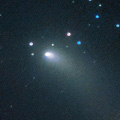
|
Now it is very bright as 9.8 mag (Feb. 10, Carlos Labordena). It will go far away from Earth after this. But it will approach to Sun down to 0.58 a.u. on Feb. 21. In the Northern Hemisphere, it stays extremely low after this. In the Southern Hemisphere, it is not observable until late March.
Date(TT) R.A. (2000) Decl. Delta r Elong. m1 Best Time(A, h)
Feb. 10 21 44.84 22 43.8 1.003 0.637 37 11.5 20:32 ( 92,-39)
Feb. 17 21 39.41 18 23.8 1.146 0.590 31 11.6 4:04 (269,-33)
|

|
It brightened up to 9.2 mag from November to December (Nov. 16, Juan Jose Gonzalez). Now it is fading. But it is bright as 12.4 mag still now (Feb. 10, Chris Wyatt). It stays observable in good condition until summer when it fades out.
Date(TT) R.A. (2000) Decl. Delta r Elong. m1 Best Time(A, h)
Feb. 10 14 22.36 1 46.4 1.086 1.673 107 12.4 3:55 (207, 50)
Feb. 17 14 27.85 2 0.2 1.066 1.715 113 12.7 4:04 (195, 52)
|

|
Now it is 13.1 mag (Jan. 17, Toshihiko Ikemura, Hirohisa Sato). It is expected to brighten up to 12 mag from 2018 to 2019. In the Northern Hemisphere, it stays observable in good condition while the comet will be brightening gradually. In the Southern Hemisphere, it is not observable until October.
Date(TT) R.A. (2000) Decl. Delta r Elong. m1 Best Time(A, h)
Feb. 10 15 33.98 68 34.3 2.753 3.133 103 12.6 3:55 (193,-17)
Feb. 17 15 18.21 72 3.0 2.693 3.097 104 12.5 4:04 (187,-18)
|
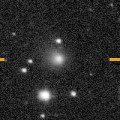
|
Now it is bright as 12.8 mag (Feb. 1, Thomas Lehmann). It is expected to brighten up to 10 mag in summer in 2018. In the Northern Hemisphere, it stays observable until 2018 summer while the comet will be brightening. It is appear in the morning sky also in the Southern Hemisphere.
Date(TT) R.A. (2000) Decl. Delta r Elong. m1 Best Time(A, h)
Feb. 10 18 56.61 3 9.5 3.653 3.003 42 13.4 3:55 (265, 2)
Feb. 17 19 3.05 2 24.9 3.545 2.953 46 13.2 4:04 (261, 8)
|

|
It brightened up to 7.1 mag from May to June in 2017 (June 21, Juan Jose Gonzalez). Now it is fading. It has already faded down to 12.9 mag (Jan. 17, Chris Wyatt). In the Southern Hemisphere, it stays observable for a long time after this. However, it will be extremely low from January to March. It will never be observable again in the Northern Hemisphere.
Date(TT) R.A. (2000) Decl. Delta r Elong. m1 Best Time(A, h)
Feb. 10 22 41.18 -49 47.9 4.125 3.400 37 13.9 20:32 ( 40, 16)
Feb. 17 22 55.94 -48 56.2 4.185 3.467 38 14.0 20:22 ( 40, 15)
|

|
It is not observable now. It will appear in the morning sky in late March in the Southern Hemisphere, or in late April in the Northern Hemisphere.
Date(TT) R.A. (2000) Decl. Delta r Elong. m1 Best Time(A, h)
Feb. 10 22 4.84 -8 57.2 6.766 5.795 9 13.9 20:32 ( 66,-16)
Feb. 17 22 10.24 -8 23.2 6.779 5.794 4 13.9 20:22 ( 65,-19)
|

|
Now it is very bright as 12.3 mag (Jan. 20, Toshihiko Ikemura, Hirohisa Sato). It will be observable at 13-14 mag for a long time from 2017 to 2018. In the Southern Hemisphere, it will be hardly observable after this.
Date(TT) R.A. (2000) Decl. Delta r Elong. m1 Best Time(A, h)
Feb. 10 16 35.40 32 34.5 3.681 3.730 85 14.1 3:55 (221, 8)
Feb. 17 16 32.90 34 53.2 3.588 3.730 90 14.1 4:04 (213, 11)
|

|
It brightened up to 8.1 mag in autumn (Oct. 3, Juan Jose Gonzalez). Now it is fading. It has already faded down to 14.2 mag (Jan. 15, Toshihiko Ikemura, Hirohisa Sato). In the Northern Hemisphere, it stays observable in good condition for a long time. In the Southern Hemisphere, it will never be observable again after this.
Date(TT) R.A. (2000) Decl. Delta r Elong. m1 Best Time(A, h)
Feb. 10 5 9.87 80 26.6 1.668 2.188 108 14.1 20:32 (178,-25)
Feb. 17 5 43.12 78 34.4 1.758 2.253 106 14.5 20:22 (179,-24)
|

|
Now it is 13.8 mag (Feb. 10, Chris Wyatt). It stays 14 mag for a while. It stays observable in the evening sky until spring.
Date(TT) R.A. (2000) Decl. Delta r Elong. m1 Best Time(A, h)
Feb. 10 2 35.64 -16 26.3 2.125 2.055 72 14.5 20:32 (100, 42)
Feb. 17 2 45.24 -12 7.2 2.207 2.075 69 14.7 20:22 (104, 38)
|

|
It approached to Earth down to 0.07 a.u. in mid December, and it brightened up to 10.4 mag (Dec. 15, Thomas Lehmann). It approached to Sun down to 0.14 a.u. on Jan. 25. But it is not observable now.
Date(TT) R.A. (2000) Decl. Delta r Elong. m1 Best Time(A, h)
Feb. 10 22 1.63 -3 29.5 1.451 0.538 13 14.9 20:32 ( 71,-20)
Feb. 17 22 36.97 1 31.5 1.587 0.697 16 15.6 20:22 ( 78,-20)
|
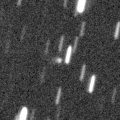
|
Now it is 15.9 mag (Jan. 15, Toshihiko Ikemura, Hirohisa Sato). It will brighten up to 9 mag in 2018 summer. However, it is hardly observable when it is bright. In the Northern Hemisphere, it is observable only until March when it brightens up to 14 mag. In the Southern Hemisphere, it is observable from July to September in 2018, but it locates in extremely low.
Date(TT) R.A. (2000) Decl. Delta r Elong. m1 Best Time(A, h)
Feb. 10 23 55.03 45 17.7 2.858 2.649 67 15.5 20:32 (130,-24)
Feb. 17 0 8.38 43 37.1 2.856 2.562 62 15.4 20:22 (128,-24)
|

|
Brian Skiff found a bright outburst on Dec. 7. It brightened up to 13.2 mag (Dec. 11, Seiichi Yoshida). It stays bright as 14.6 mag still now (Jan. 19, Sandor Szabo). This is the 4th outburst following those in January 2006, May 2011 and August 2016. It stays observable in good condition for a while.
Date(TT) R.A. (2000) Decl. Delta r Elong. m1 Best Time(A, h)
Feb. 10 2 40.06 11 51.9 7.559 7.458 80 15.4 20:32 (127, 25)
Feb. 17 2 42.20 12 4.3 7.689 7.476 73 15.7 20:22 (124, 22)
|
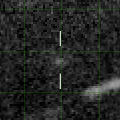
|
Now it is 17.2 mag (Jan. 14, iTelescope Observatory, Siding Spring). It will be observable at 14 mag in good condition from spring to summer.
Date(TT) R.A. (2000) Decl. Delta r Elong. m1 Best Time(A, h)
Feb. 10 17 40.65 -30 34.9 2.167 1.802 55 15.8 3:55 (286, 35)
Feb. 17 18 2.57 -30 40.4 2.091 1.773 57 15.6 4:04 (284, 38)
|
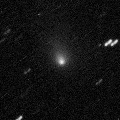
|
It brightened very rapidly up to 13.8 mag in August (Aug. 22, kunihiro Shima). After that, it is fading gradually. Now it is 15.5 mag (Jan. 20, Kunihiro Shima). It will be unobservable in March.
Date(TT) R.A. (2000) Decl. Delta r Elong. m1 Best Time(A, h)
Feb. 10 1 10.32 -6 41.8 2.697 2.259 53 15.8 20:32 ( 96, 20)
Feb. 17 1 21.12 -4 34.2 2.744 2.242 50 15.9 20:22 ( 97, 17)
|
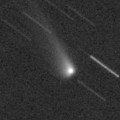
|
Now it is 16.2 mag (Jan. 12, Toshihiko Ikemura, Hirohisa Sato). It will be unobservable temporarily soon.
Date(TT) R.A. (2000) Decl. Delta r Elong. m1 Best Time(A, h)
Feb. 10 0 15.43 -3 20.1 4.980 4.291 41 15.8 20:32 ( 91, 6)
Feb. 17 0 17.69 -3 39.9 5.070 4.297 34 15.9 20:22 ( 88, 3)
|

|
Now it is 16.4 mag (Jan. 12, Toshihiko Ikemura, Hirohisa Sato). It stays 16-17 mag for a long time from 2016 to 2019. It stays near by the equator.
Date(TT) R.A. (2000) Decl. Delta r Elong. m1 Best Time(A, h)
Feb. 10 10 28.92 5 34.5 8.643 9.594 163 15.8 1:11 (180, 50)
Feb. 17 10 27.41 5 53.8 8.621 9.598 170 15.8 0:42 (180, 49)
|
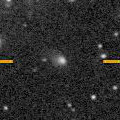
|
Now it is 16.1 mag (Jan. 8, Alexander Baransky). It is expected to brighten up to 13-14 mag from 2018 to 2019. In the Northern Hemisphere, it stays observable in good condition for a long time. In the Southern Hemisphere, it is not observable until summer in 2018.
Date(TT) R.A. (2000) Decl. Delta r Elong. m1 Best Time(A, h)
Feb. 10 19 26.53 38 32.5 4.933 4.534 60 16.0 3:55 (238,-23)
Feb. 17 19 30.07 38 39.6 4.874 4.492 61 16.0 4:04 (235,-17)
|

|
Now it is 16.1 mag (Jan. 15, Toshihiko Ikemura, Hirohisa Sato). It will be observable at 16 mag in good condition from winter to spring.
Date(TT) R.A. (2000) Decl. Delta r Elong. m1 Best Time(A, h)
Feb. 10 11 58.15 9 45.9 2.688 3.537 144 16.0 2:40 (180, 45)
Feb. 17 11 55.55 10 14.5 2.636 3.537 151 16.0 2:10 (180, 45)
|

|
It stays 15 mag from 2018 to 2019, and it will be observable for a long time in the Southern Hemisphere. In the Northern Hemisphere, it will never be observable again.
Date(TT) R.A. (2000) Decl. Delta r Elong. m1 Best Time(A, h)
Feb. 10 14 11.47 -55 32.3 4.877 4.962 89 16.1 3:55 (339, 67)
Feb. 17 14 11.88 -57 4.8 4.762 4.927 93 16.0 4:04 (352, 68)
|
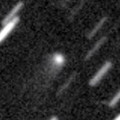
|
Now it is 15.3 mag (Jan. 19, Sandor Szabo). It stays 16 mag for a long time from 2017 to 2018. It is observable in excellent condition in the Northern Hemisphere. It locates very low in the Southern Hemisphere.
Date(TT) R.A. (2000) Decl. Delta r Elong. m1 Best Time(A, h)
Feb. 10 7 55.00 40 43.1 4.512 5.360 146 16.1 22:33 (180, 14)
Feb. 17 7 46.05 41 32.6 4.586 5.366 138 16.1 21:56 (180, 13)
|

|
It brightened up to 9.7 mag in November (Nov. 16, Juan Jose Gonzalez). Now it is fading rapidly. It has already faded down to 13.0 mag (Feb. 10, Chris Wyatt).
Date(TT) R.A. (2000) Decl. Delta r Elong. m1 Best Time(A, h)
Feb. 10 16 10.95 -10 32.2 1.492 1.614 78 16.2 3:55 (250, 43)
Feb. 17 16 21.92 -11 5.2 1.479 1.670 82 16.6 4:04 (244, 48)
|

|
Now it is 16.9 mag (Jan. 15, Alexander Baransky). It stays 17 mag in 2018.
Date(TT) R.A. (2000) Decl. Delta r Elong. m1 Best Time(A, h)
Feb. 10 3 16.84 0 33.1 6.558 6.566 86 16.3 20:32 (126, 39)
Feb. 17 3 19.02 0 55.4 6.697 6.597 80 16.3 20:22 (122, 36)
|
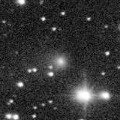
|
Now it is 15.8 mag (Jan. 14, Toshihiko Ikemura, Hirohisa Sato). It will be fading after this. In the Northern Hemisphere, it stays observable in the northern sky for a long time. It is not observable at all after this in the Southern Hemisphere.
Date(TT) R.A. (2000) Decl. Delta r Elong. m1 Best Time(A, h)
Feb. 10 20 54.87 67 56.9 3.475 3.491 82 16.3 3:55 (207,-41)
Feb. 17 21 5.38 69 32.6 3.511 3.518 82 16.3 4:04 (205,-39)
|

|
It will brighten up to 16 mag in spring. In the Southern Hemisphere, it stays observable until August, but it will be unobservable after that. In the Northern Hemisphere, it stays unobservable until June, but it will be observable in good condition after that.
Date(TT) R.A. (2000) Decl. Delta r Elong. m1 Best Time(A, h)
Feb. 10 17 58.59 -47 1.2 2.000 1.646 54 16.9 3:55 (306, 37)
Feb. 17 18 32.57 -47 35.6 1.921 1.593 55 16.8 4:04 (307, 38)
|

|
Now it is 16.4 mag (Jan. 19, Kunihiro Shima). It will pass the perihelion in 2019. However, it has not been brightening since the discovery in 2010. It is observable in good conditioin in the Northern Hemisphere. It is not observable for a long time in the Southern Hemisphere.
Date(TT) R.A. (2000) Decl. Delta r Elong. m1 Best Time(A, h)
Feb. 10 5 41.47 76 6.9 8.330 8.740 111 16.8 20:32 (179,-21)
Feb. 17 5 39.08 75 47.3 8.379 8.730 107 16.8 20:22 (178,-21)
|

|
Now it is 17.4 mag (Jan. 12, Toshihiko Ikemura, Hirohisa Sato). It will be fading after this, and will be fainter than 18 mag in April.
Date(TT) R.A. (2000) Decl. Delta r Elong. m1 Best Time(A, h)
Feb. 10 9 41.91 -15 50.4 2.209 3.100 149 16.8 0:24 (180, 71)
Feb. 17 9 37.63 -15 58.2 2.234 3.137 151 16.9 23:47 (180, 71)
|

|
Now it is 16.3 mag (Jan. 18, Toshihiko Ikemura, Hirohisa Sato). It will be fading gradually after this, and it will be fainter than 18 mag in autumn. In the Northern Hemisphere, it stays observable in good condition for a long time. In the Southern Hemisphere, it will never be observable again.
Date(TT) R.A. (2000) Decl. Delta r Elong. m1 Best Time(A, h)
Feb. 10 20 46.77 60 25.9 7.068 6.888 75 17.0 3:55 (217,-41)
Feb. 17 20 58.05 60 54.5 7.112 6.908 74 17.0 4:04 (216,-38)
|
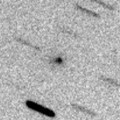
|
Now it is 17.3 mag (Jan. 20, Toshihiko Ikemura, Hirohisa Sato). It stays observable at 17 mag in good condition for a while. It will be fainter than 18 mag in May.
Date(TT) R.A. (2000) Decl. Delta r Elong. m1 Best Time(A, h)
Feb. 10 15 7.03 -8 0.2 2.105 2.391 94 17.0 3:55 (231, 53)
Feb. 17 15 12.73 -7 58.1 2.051 2.425 99 17.1 4:04 (220, 57)
|

|
Now it is 17.0 mag (Jan. 18, Toshihiko Ikemura, Hirohisa Sato). It stays observable at 18 mag for a long time until 2019.
Date(TT) R.A. (2000) Decl. Delta r Elong. m1 Best Time(A, h)
Feb. 10 5 43.10 17 0.8 7.339 7.943 124 17.3 20:32 (177, 38)
Feb. 17 5 39.35 16 50.4 7.445 7.940 116 17.4 20:22 (170, 38)
|
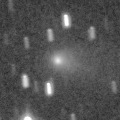
|
It brightened up to 14.8 mag from autumn to winter (Nov. 21, Hiroshi Abe). Now it is fading. It has already faded down to 16.2 mag (Jan. 18, Toshihiko Ikemura, Hirohisa Sato). It is observable in good condition in the Northern Hemisphere. It locates low in the Southern Hemisphere.
Date(TT) R.A. (2000) Decl. Delta r Elong. m1 Best Time(A, h)
Feb. 10 5 9.08 37 47.1 1.755 2.379 117 17.4 20:32 (171, 17)
Feb. 17 5 15.35 37 21.7 1.862 2.414 112 17.6 20:22 (169, 17)
|

|
Now it is 16.8 mag (Jan. 15, Alexander Baransky). It will be fading after this, and will be fainter than 18 mag in March. It is observable in excellent condition in the Northern Hemisphere. It locates low in the Southern Hemisphere.
Date(TT) R.A. (2000) Decl. Delta r Elong. m1 Best Time(A, h)
Feb. 10 5 2.57 34 12.5 2.840 3.396 116 17.5 20:32 (169, 20)
Feb. 17 5 5.36 33 56.7 2.952 3.419 110 17.6 20:22 (166, 19)
|
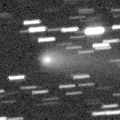
|
It brightened up to 12.2 mag in August (Aug. 21, Juan Jose Gonzalez). It is fading now. It has already faded down to 16.8 mag (Jan. 24, Alexander Baransky).
Date(TT) R.A. (2000) Decl. Delta r Elong. m1 Best Time(A, h)
Feb. 10 7 15.01 20 16.8 1.730 2.610 146 17.5 21:53 (180, 35)
Feb. 17 7 12.20 20 54.6 1.841 2.665 138 17.8 21:23 (180, 34)
|
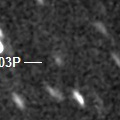
|
Now it is 18.4 mag (Jan. 15, Toshihiko Ikemura, Hirohisa Sato). It will be fading slowly after this.
Date(TT) R.A. (2000) Decl. Delta r Elong. m1 Best Time(A, h)
Feb. 10 11 51.78 -13 49.7 2.466 3.244 135 17.6 2:33 (180, 69)
Feb. 17 11 46.69 -13 24.8 2.446 3.292 143 17.6 2:01 (180, 69)
|

|
Now it is 19.1 mag (Jan. 24, Observatoire Chante-Perdrix, Dauban). It will brighten rapidly after this, and will brighten up to 12 mag from April to June. In the Southern Hemisphere, it stays observable in excellent condition. In the Northern Hemisphere, it will be unobservable from April to June when the comet becomes brightest.
Date(TT) R.A. (2000) Decl. Delta r Elong. m1 Best Time(A, h)
Feb. 10 15 56.68 -23 7.4 1.709 1.805 79 18.0 3:55 (263, 53)
Feb. 17 16 15.99 -25 14.9 1.595 1.747 81 17.6 4:04 (263, 57)
|

|
Now it is 17.4 mag (Jan. 17, Toshihiko Ikemura, Hirohisa Sato). It was observed at 17 mag in former 2017. It will be observable at 18 mag in good condition from winter to spring.
Date(TT) R.A. (2000) Decl. Delta r Elong. m1 Best Time(A, h)
Feb. 10 12 41.61 10 50.3 4.711 5.443 134 17.7 3:23 (180, 44)
Feb. 17 12 36.98 12 21.6 4.653 5.465 141 17.7 2:51 (180, 43)
|
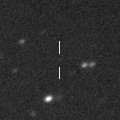
|
It is observable at 17.5 mag in good condition from February to April. However, now it is 19.2 mag (Jan. 15, Toshihiko Ikemura, Hirohisa Sato), fainter than predicted.
Date(TT) R.A. (2000) Decl. Delta r Elong. m1 Best Time(A, h)
Feb. 10 12 2.91 -8 11.9 1.939 2.740 136 17.8 2:44 (180, 63)
Feb. 17 12 1.66 -7 57.5 1.877 2.737 143 17.7 2:16 (180, 63)
|

|
Now it is 17.0 mag (Jan. 20, Toshihiko Ikemura, Hirohisa Sato). It was observed at 17 mag in 2017. It will be observable at 18 mag in 2018.
Date(TT) R.A. (2000) Decl. Delta r Elong. m1 Best Time(A, h)
Feb. 10 15 4.16 -19 42.7 6.072 6.182 91 17.8 3:55 (245, 61)
Feb. 17 15 5.19 -19 11.8 5.969 6.197 98 17.8 4:04 (231, 67)
|
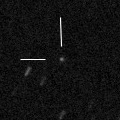
|
Now it is 17.4 mag (Jan. 20, Toshihiko Ikemura, Hirohisa Sato). It will brighten up to 15.5 mag in January, 2019. It stays observable in excellent condition in the Northern Hemispehre. It is observable only until June, 2018, in the Southern Hemisphere.
Date(TT) R.A. (2000) Decl. Delta r Elong. m1 Best Time(A, h)
Feb. 10 12 47.86 14 20.7 3.775 4.506 132 17.9 3:29 (180, 41)
Feb. 17 12 41.62 16 14.3 3.654 4.464 140 17.8 2:56 (180, 39)
|
|
![]()
 C/2010 U3 ( Boattini )
C/2010 U3 ( Boattini ) C/2016 T3 ( PanSTARRS )
C/2016 T3 ( PanSTARRS ) C/2014 OE4 ( PanSTARRS )
C/2014 OE4 ( PanSTARRS ) 30P/Reinmuth 1
30P/Reinmuth 1 C/2015 XY1 ( Lemmon )
C/2015 XY1 ( Lemmon ) 145P/Shoemaker-Levy 5
145P/Shoemaker-Levy 5 90P/Gehrels 1
90P/Gehrels 1 217P/LINEAR
217P/LINEAR 103P/Hartley 2
103P/Hartley 2 66P/du Toit
66P/du Toit C/2017 D3 ( ATLAS )
C/2017 D3 ( ATLAS ) 235P/LINEAR
235P/LINEAR C/2017 E3 ( PanSTARRS )
C/2017 E3 ( PanSTARRS ) C/2018 A3 ( ATLAS )
C/2018 A3 ( ATLAS )![]()






































